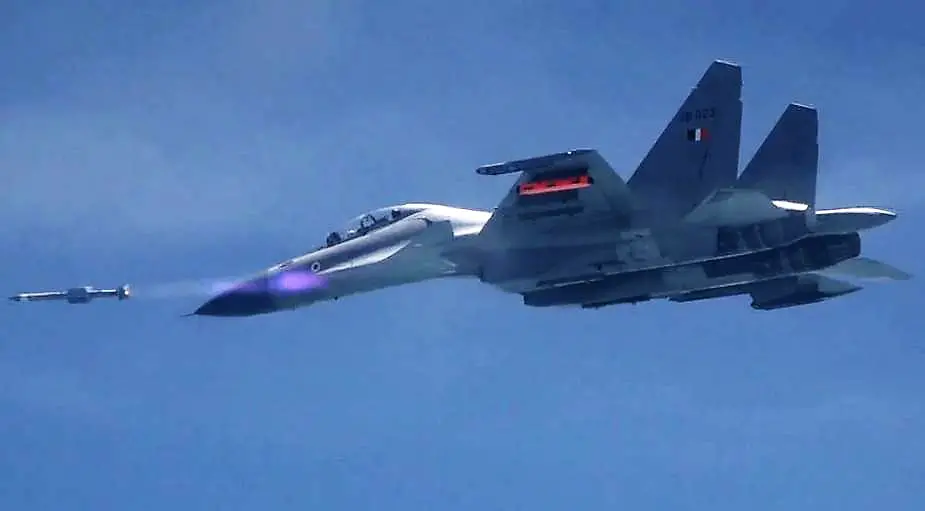According to Air Force Technology, the Indian Ministry of Defence (MoD) has signed a contract with Bharat Dynamics (BDL) to procure Astra MK-I beyond visual range (BVR) air-to-air missile (AAM). The Astra MK-I missile will be used by the Indian Air Force (IAF) and Navy. The contract falls under the Buy Indian Designed, Developed and Manufactured (Indian-IDDM) category.
Follow Air Recognition on Google News at this link
 Astra Air-to-Air missile successfully flight-tested from an IAF’s Su-30 MKI. (Picture source: Indian Ministry of Defence/commons.wikimedia.org)
Astra Air-to-Air missile successfully flight-tested from an IAF’s Su-30 MKI. (Picture source: Indian Ministry of Defence/commons.wikimedia.org)
Astra is an all-weather beyond-visual-range active radar homing air-to-air missile, developed by the Defence Research and Development Organisation (DRDO). It is the first air-to-air missile developed by India. Astra is designed to be capable of engaging targets at varying ranges and altitudes allowing for engagement of both short-range targets at a distance of 10 km (6.2 miles) and long-range targets up to a distance of 110 km (68 miles). Astra has been integrated with Indian Air Force's Sukhoi Su-30MkI and will be integrated with Dassault Mirage 2000, HAL Tejas and Mikoyan MiG-29 in the future. Limited series production of Astra missiles began in 2017.
Astra's older design resembled Matra Super 530D and Vympel R-77 in a few aspects. Astra is 3.6 m (12 ft) long with a diameter of 178 mm (7.0 in) and weighs 154 kg (340 lb). It uses mid-course inertial guidance driven by a fiber optic gyroscope with terminal guidance through active radar homing. It is capable of receiving course corrections through a secure data link. The missile's active radar seeker with a homing range of 25 km (16 mi) is supplied by Agat and will be manufactured locally. The seeker can lock on to a target with a radar cross-section of 5 square meters from a distance of 15 km and enables off-boresight launches up to an angle of 45°. Some tests have been conducted in 2017 and 2018 using an indigenous seeker developed by Research Centre Imarat.
Astra is equipped with electronic counter-countermeasures to allow operation even during enemy attempts to jam the seeker using electronic countermeasures. It carries a 15 kg (33 lb) high explosive pre-fragmented warhead activated by a proximity fuse. Astra uses a smokeless solid fuelled motor that can propel the missile to a speed of Mach 4.5 and allows operation from a maximum altitude of 20 km (66,000 ft). The maximum range of Astra is 20 km (12 mi) in tail chase mode and 110 km (68 mi) in head-on chase mode. The maximum range is achieved when the missile is launched from an altitude of 15 km (49,000 ft). When it is fired from an altitude of 8 km (26,000 ft), the range drops to 44 km (27 mi) and when it is launched from sea level, the range drops further to 21 km (13 mi). Astra's low aspect ratio wings allow it to engage maneuvering targets up to a range of 90 km (56 mi) in head-on chase mode and 60 km (37 mi) in tail chase mode. It can be launched in both autonomous and buddy mode operation and can lock on to its target before or after it is launched.
In 2019, the Indian Air Force conducted successful trials of the Astra from its Su-30 MKI fighter. The integration of the Astra missile with the Su-30 MKI is now complete. According to the MoD, the missile’s integration with the IAF’s other fighter jets, including light combat aircraft Tejas, will be carried out in a phased manner. Apart from the IAF, the Indian Navy will integrate the Astra missile on its MiG-29K fighter jets.
In a statement, the MoD said: “The transfer of technology from DRDO to BDL for production of Astra Mk-I missile and all associated systems has been completed and production at BDL is in progress”. The new contract will further support the development of infrastructure and testing facilities at BDL, Air Force Technology reports.
















